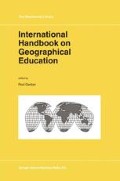Abstract
The introduction of new media is changing geography education fast. Especially the introduction of the Internet offers the opportunity to study almost every place in the world anytime anywhere. Although there are some problems related to the introduction of new media in geographic education, the advantages far outweigh the problems. To make optimal use of new media in geography teaching systematic international research and development in this field should be developed to enhance the quality of modern geography teaching.
Access this chapter
Tax calculation will be finalised at checkout
Purchases are for personal use only
Preview
Unable to display preview. Download preview PDF.
References
Albrecht, V. (1996) Computer simulation and environmental learning: an approach to Geolab. In Innovation in Geographical Education. Netherlands Geographical Studies 208,J. van der Schee et al.,(eds.) Utrecht: KNAG, 145–154.
Bednarz, S. and Audet, R. (1999) The status of GIS technology in teacher preparation programs. Journal of Geography, 98: 60–67.
Dewey, J. (1975) Experience and Education. New York: Macmillan.
Driver, R. et al. (1994) Constructing scientific knowledge in the classroom. Educational Researcher, 23 (7): 5–12.
Durndell, A. and Thomson, K. (1997) Gender and computing: a decade of change? Computers and Education, 28 (1): 1–9
Fitzpatrick, C. (1990) Computers in geography instruction. Journal of Geography, 89: 148–149. Fitzpatrick, C. (1993) Teaching geography with computers. Journal of Geography, 92: 4.
Foskett, N. and Bradshaw, M. (2000) Developing International Geography Tests on the Web: The EU European Geography Test (EGT) Project. In Research Forum 2, Information and Communications Technology, Kent, W. (ed.) London: IGU Commission on Geographical Education and Institute of Education of the University of London, 49–64.
Ruck, A. (2000) Information technology in the child’s world. In M. Robertson and R. Gerber, (eds.) The Child’s World, Triggers for Learning, Melbourne: ACER Press, 109–130.
Giesen, P. (2000) Chatten alsof het seks is. De Volkskrant, 19 september 3S.
Gillespie, F. (1998) Instructional design for the new technologies. The impact of technology on faculty development, life, and work. New Directions for Teaching and Learning, 76.
Gutierrez-Diaz, M. (2001) Prometeus Newsletter Editorial,9.
Healy, M. (1992) Curriculum development and `enterprise’: group work, resource based learning and the incorporation of transferable skills into a first year practical course. Journal of Geography in Higher Education, 16 (1): 7–20.
Hill, A., and Solem, M. (1999) Geography on the Web–changing the learning paradigm. Journal of Geography, 98: 100–107.
Kam Tin Seong (1996) Interactive Multimedia and GIS Applications for Teaching School Geography. International Research in Geographical and Environmental Education, 5 (3): 205–212.
Leask, M. (1999) Teaching and learning with ICT: an introduction. In Learning to Teach in the Secondary School, S. Capel, M. Leask and T. Turner, Second Edition. London: Routledge.
Martin, F. (2000) Models for ICT training in geography. In Research Forum 2, Information and Communications Technology, W. Kent (ed.) London: IGU. Commission on Geographical Education and Institute of Education of the University of London, 65–70.
McCluskey, L. (1994) Gresham’s law, technology, and education. Phi Delta Kappa, 75 (7): 550–552.
Nellis, M. (1994) Technology in geographic education: reflections and future directions. In R. Bednarz, J. Peterson (eds.) A Decade of Reform in Geographical Education: Inventory and Prospect, Indiana PA: National Council of Geographical Education, 51–57.
Nichol, J. and Goh Kim Chuan. (1996) The status of GIS in undergraduate geography in Singapore. International Research in Geographical and Environmental Education, 5 (3): 199–204.
Northup, T., Barth, J. and Kranze, H. (1991) Technology standards for social studies. Social Education, 55: 218–220.
Schee, J.A. van der. (2000) Helping children to analyse a changing world:lLooking for patterns and relationships in space. In M. Robertson, R. Gerber (eds.) The Child’s World, Triggers for Learning, Melbourne: ACER Press, 214–231.
Sharpe, B. (2000) Virtual geographies as instructional technologies: evaluation and assessment. In: International Textbook Research — Virtual Geography Texts (VGT), Hecht, A. and Pletsch, A. Braunschweig: Georg-Eckert-Institut, 22: 261–273.
Trimp, H. (1996) Old and new media. In: Innovation in Geographical Education. Netherlands Geographical Studies 208,. J.van der Schee et al. (eds.) Utrecht: KNAG, 113–114.
Watson, D. (2000) Issues raised by research into ICT and geography education. In W. Kent, (ed.) Research Forum 2, Information and Communications Technology, London: IGU Commission on Geographical Education and Institute of Education of the University of London, 2000: 21–32.
Wiegand, P. and Tait, K. (2000) The development and piloting of a software cartographic tool giving user control over small-scale thematic maps. In W. Kent. (ed.) Research Forum 2, Information and Communications Technology, London: IGU Commission on Geographical Education and Institute of Education of the University of London, 1–20.
Editor information
Editors and Affiliations
Rights and permissions
Copyright information
© 2003 Springer Science+Business Media Dordrecht
About this chapter
Cite this chapter
van der Schee, J. (2003). New Media Will Accelerate the Renewal of Geographic Education. In: Gerber, R. (eds) International Handbook on Geographical Education. The GeoJournal Library, vol 73. Springer, Dordrecht. https://doi.org/10.1007/978-94-017-1942-1_14
Download citation
DOI: https://doi.org/10.1007/978-94-017-1942-1_14
Publisher Name: Springer, Dordrecht
Print ISBN: 978-90-481-6172-0
Online ISBN: 978-94-017-1942-1
eBook Packages: Springer Book Archive

